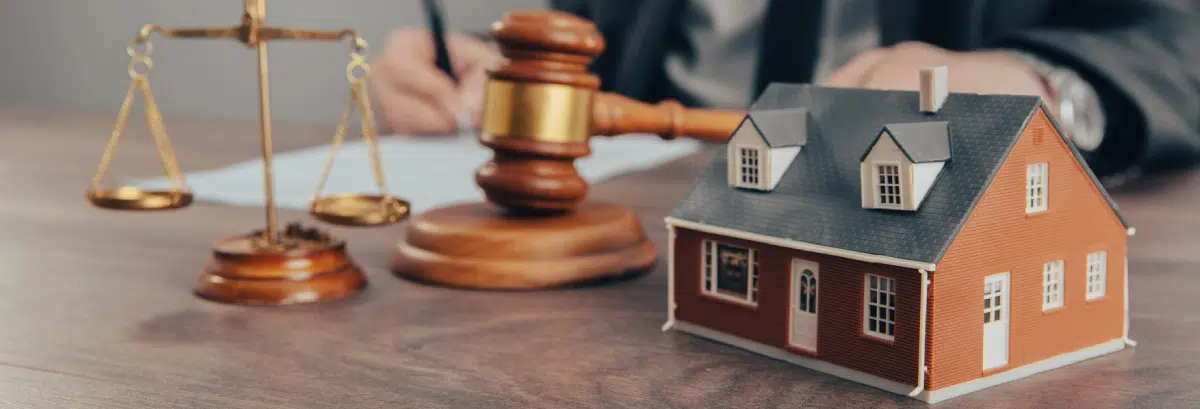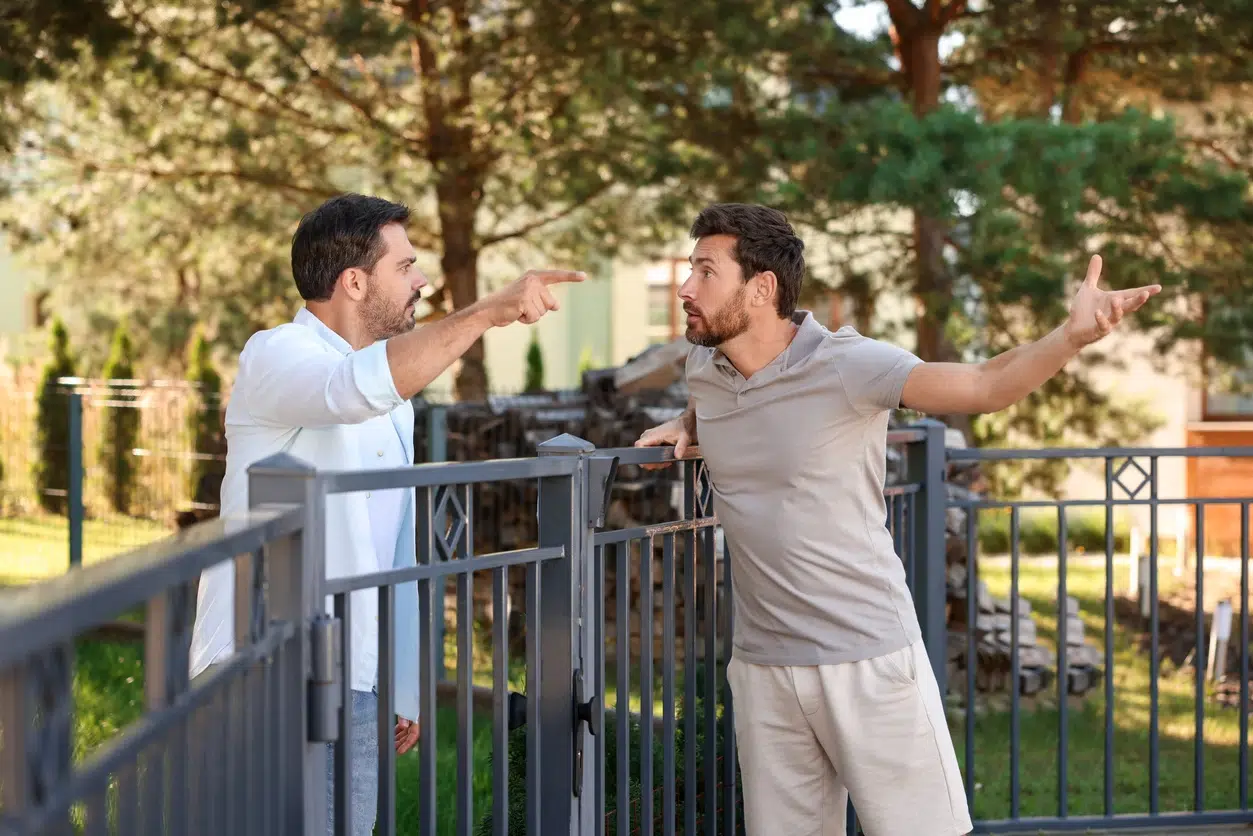
Do you need help determining your property line or resolving a fencing issue? Estavillo Law Group can help! Call us today at (510) 982-3001 or reach out through our online contact form and one of our experienced real estate lawyers will be in touch.
The Bay Area has a particularly colorful history when it comes to fence disputes. In one notable case nearly 150 years ago, a San Francisco man named Charles Cocker erected a 40-foot fence to annoy his neighbor who refused to sell a plot of land that Cocker intended to add to his already existent 12,000 square foot estate.
As retaliation, the man on the other side of the 40-foot monstrosity, Nicholas Yung, threatened to erect an even taller flag pole adorned with a skull and crossbones flag flown high over the now famous fence.
This fence is known today as “The San Francisco Spite Fence”, and it’s just one example of how a simple dispute can turn disastrous when two neighbors are left to their creative devices.
Fortunately, in the 21st Century, we have civil codes available to help us settle fence disputes and other forms of real estate issues that may arise between neighbors without having to resort to “spite fences.” If you need help settling a fence dispute in your neighborhood, we’d love to hear from you. Estavillo Law Group has served the Bay Area for over 50 years and has a dedicated and efficient approach to real estate law. Call us today at (510) 982-3001 or reach out through our online contact form for a consultation.
Fence Dispute Legal Issues
When we think about legal issues surrounding neighbors and their fences, a majority of the problems stem from not understanding where the property lines are actually located.
Perhaps one neighbor is fine with the fence being there, but they aren’t OK with the fence running through their property. Or one neighbor is in the process of erecting a fence, but the other neighbor is claiming that doing so would be a violation of the property lines.
When these types of situations arise, it’s possible for even more issues to be uncovered while attempting to determine where the property lines start and end. What happens when it’s discovered that a deed says that the property lines end in one location and the realtor who sold the property says that ends in another location? Or that there are conflicting records about both neighbors’ property lines.
The solution is typically reached through mediation with the help of surveyor and/or experienced mediator along with a real estate lawyer and a compromise or concession by one or both property owners.
Why Might a Fence Dispute Arise?
Apart from confusion regarding the boundary lines, there are a number of reasons why a fence dispute may arise between two neighbors. Here are a few common reasons our law firm has seen:
- Maintenance and Repair Costs: Disagreements may arise when one neighbor wants to repair or replace the fence while the other does not want to contribute to the cost. Issues can also arise if one neighbor believes the other is responsible for maintaining the fence.
- Type and Appearance of the Fence: Differences in opinion regarding the type, height, and appearance of the fence can lead to disputes. For example, one neighbor may want to install a privacy fence, while the other prefers a lower, more open design.
- Sunlight or Wind Blockage: One common reason for a fence dispute between homeowners is that it blocks the sunlight or wind from one or both properties. This can result in one neighbor being unable to grow a garden or receive the proper aeration.
- Noise and Privacy Concerns: If a fence affects the privacy or noise levels of one neighbor’s property, it can lead to disputes about the fence’s height or design.
- Pets and Children: Disputes may arise if one neighbor’s pets or children damage or disturb the other neighbor’s property through the fence.
- Shared Ownership: In some cases, both neighbors may claim ownership of the fence, leading to disagreements over maintenance, repairs, and alterations.
- Misunderstandings and Communication Issues: Sometimes, fence disputes stem from misunderstandings or lack of communication between neighbors regarding their expectations and responsibilities regarding the fence.
Do you have an issue or a combination of issues similar to the one listed above? Do you have a neighbor who simply isn’t open to discussion concerning the construction of a fence or a boundary dispute? Estavillo Law Group can help you and your neighbor come to a solution and bring peace back to the neighborhood. Give us a call at (510) 982-3001 or through our online contact form and we’ll have someone form our team get in touch with you right away.
Fence Dispute Law
Regardless of the confusion that may come with assessing a property’s boundaries, determining cases of destruction of property, or violations of peaceful enjoyment, there are laws in place to make sure that both parties are able to enjoy their property to the best of their ability and without infringing on the rights of the other neighbor.
Here a few laws we may draw from to determine the next steps in a fence dispute in California, most of which come from California Civil Code § 841:
- Responsibility for Maintenance and Repair: In California, adjoining landowners are generally equally responsible for the reasonable costs of construction, maintenance, or necessary replacement of a fence dividing their properties, unless otherwise agreed upon in writing (California Civil Code § 841).
- Mutual Agreement: If both neighbors agree to the construction, maintenance, or repair of a fence, they can enter into a written agreement specifying each party’s rights and responsibilities (California Civil Code § 841).
- Cost Sharing: If one neighbor wants to construct a fence but the other does not, the neighbor who desires the fence may build it at their own expense. However, they can still seek contributions from the adjoining landowner for half the reasonable cost (California Civil Code § 841).
- Notice Requirements: Before constructing a fence, a landowner must provide a written notice to the adjoining landowner, specifying the type of fence, the materials to be used, the estimated costs, and the proposed timeline for construction (California Civil Code § 841.4).
- Dispute Resolution: If there is a disagreement regarding the need for a fence, its maintenance, or the apportionment of costs, either landowner can initiate legal action to resolve the dispute (California Civil Code § 841.4).
- Boundary Determination: If there is uncertainty regarding the true boundary line between adjoining properties, either landowner can initiate a legal action to determine the correct boundary line (California Civil Code § 841.2).
If a fence dispute or property line dispute is unable to be resolved from an open dialogue between neighbors, we may try and research other areas of real estate law that may address the specific circumstances of the dispute, hopefully avoiding mediation.
Who Is Responsible for Fences Between Neighbors?
Generally speaking, the responsibility for fences between neighbors is typically shared equally among the adjoining landowners.
According to the California Civil Code sections 841 through 848, both neighbors are generally responsible for the reasonable costs associated with the construction, maintenance, or necessary replacement of a common fence dividing their properties.
This means that unless there is a written agreement specifying otherwise (such as one issued by a homeowners’ association), the costs are divided equally between the neighbors.
However, if one neighbor wishes to construct, repair, or replace a fence but the other neighbor does not, the initiating neighbor can proceed with the work at their own expense. Despite this, they still have the right to seek contributions from the adjoining landowner for half of the reasonable costs.
The laws regarding fence responsibilities are designed to promote fairness and cooperation between neighbors while providing a legal framework for resolving disputes that may arise regarding the construction, maintenance, or repair of fences dividing adjoining properties.

How Do You Settle a Fence Dispute?
Depending on how willing you and your neighbor are to resolve the issue regarding the fence, the dispute may be as simple as having a quick chat with your neighbor about the property line or its encroachment on your property or peaceful enjoyment rights.
However, if your neighbor is unwilling or unable to see your side of the situation, you may have to go through alternative avenues, such as mediation.
It’s often best to speak with an attorney before doing or saying anything related to a potential legal matter. And remember to keep all communications between you and your neighbor calm and amicable. If you sense that things are escalating, it’s often best to remove yourself from the conversation.
If you and your neighbor are unable to resolve the fence dispute, here are some possible next steps:
- Review Property Deeds and Local Regulations: It’s important to review the property deeds and local regulations regarding fences in your area. This can help determine who is responsible for the fence and what rules govern its construction and maintenance.
- Mediation: If communication with your neighbor does not resolve the issue, you may consider mediation. Mediation involves a neutral third party who helps facilitate a discussion between you and your neighbor to reach a mutually acceptable solution. Mediation can be less costly and time-consuming than going to court.
- Legal Action: If all other attempts at resolution fail, you may need to consider legal action. This typically involves filing a lawsuit in civil court. The court will consider evidence from both parties and make a decision based on property deeds, local regulations, and other relevant factors.
- Court Decision: If the dispute goes to court, the judge will hear arguments from both sides and make a decision based on the evidence presented. The court’s decision is legally binding and must be followed by both parties.
- Appeal: In some cases, either party may choose to appeal the court’s decision if they believe it was made in error or was unfair. The appeals process can vary depending on local laws and procedures.
An attorney can help you determine the best next steps in your unique situation.
Throughout the process, it’s important to keep records of all communication, including letters, emails, and documentation related to the dispute. This can help support your case if the matter escalates to mediation or court.

Contact a Qualified Bay Area Fence Dispute Lawyer
If the situation does escalate beyond the communication phase, speak with an experienced and qualified real estate attorney.
At first, a fence dispute may seem like a trivial conflict between neighbors, but Estavillo Law Group has seen these situations escalate to disastrous proportions with even minimal direct communication between neighbors.
Call our office at (510) 982-3001 or reach out through our online contact form and tell us a little bit about your situation. Our firm has helped people like you with fence disputes as well as many other types of property disputes in the Bay Area for over 50 years.

